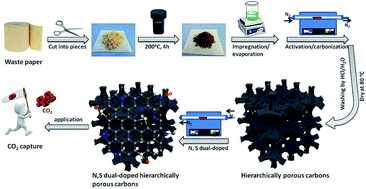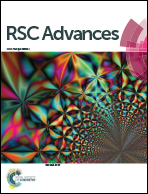Biowaste-derived 3D honeycomb-like N and S dual-doped hierarchically porous carbons for high-efficient CO2 capture†
Abstract
Considering the characteristics of abundant narrow micropores of <1 nm, appropriate proportion of mesopores/macropores and suitable surface functionalization for a highly-efficient carbon-based CO2 adsorbent, we proposed a facile and cost-effective strategy to prepare N and S dual-doped carbons with well-interconnected hierarchical pores. Benefiting from the unique structural features, the resultant optimal material showed a prominent CO2 uptake of up to 7.76 and 5.19 mmol g−1 at 273 and 298 K under 1 bar, and importantly, a superb CO2 uptake of 1.51 mmol g−1 at 298 K and 0.15 bar was achieved, which was greatly significant for CO2 capture from the post-combustion flue gases in practical application. A systematic study demonstrated that the synergetic effect of ultramicroporosity and surface functionalization determined the CO2 capture properties of porous carbons, and the synergistic influence mechanism of nitrogen/sulfur dual-doping on CO2 capture performance was also investigated in detail. Importantly, such as-prepared carbon-based CO2 adsorbents also showed an outstanding recyclability and CO2/N2 selectivity. In view of cost-effective fabrication, the excellent adsorption capacity, high selectivity and simple regeneration, our developed strategy was valid and convenient to design a novel and highly-efficient carbonaceous adsorbent for large-scale CO2 capture and separation from post-combustion flue gases.



 Please wait while we load your content...
Please wait while we load your content...